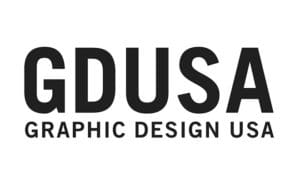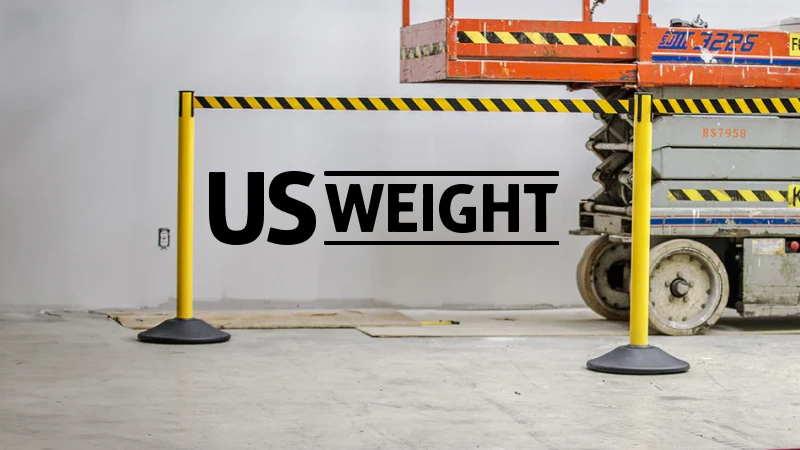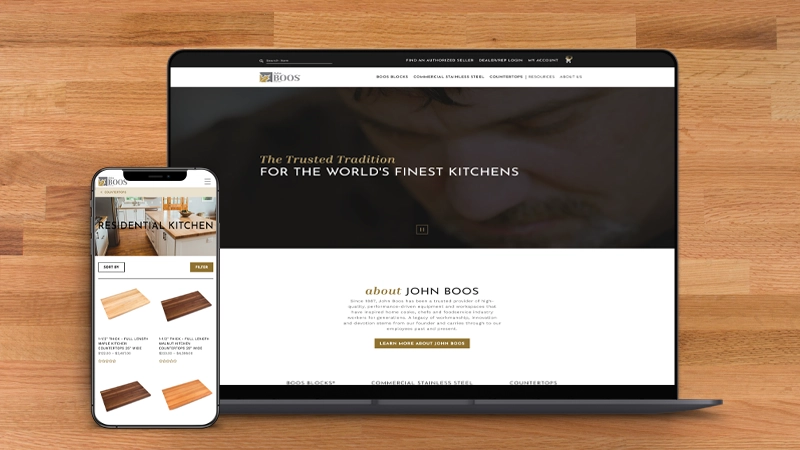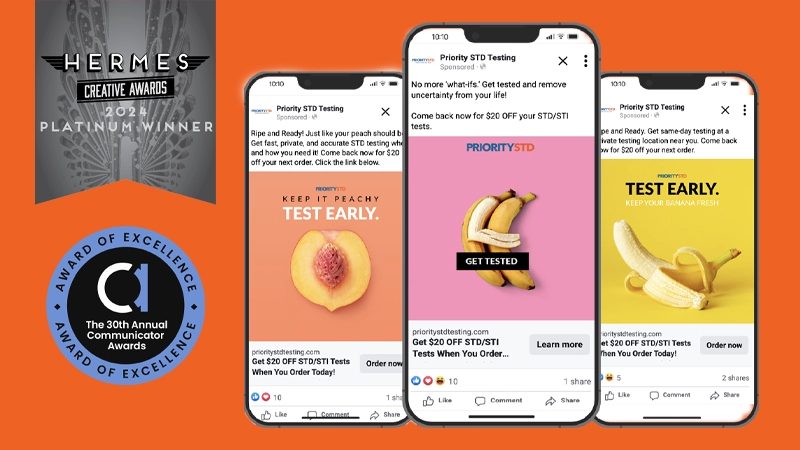There are few goal and conversion pathways more clear than that of an eCommerce website: sell products directly to consumers. But don’t let a relatively simple and straightforward goal lure you into thinking that building a great eCommerce site is easy.
eCommerce Website Design Services
Custom Solutions
There’s no shortage of online services that allow you to put up a quick and simple eCommerce site. But know this: It’s going to look like a quick and simple eCommerce site, which isn’t the most endearing or reassuring to most customers. A custom eCommerce site gives you full control of how your site looks and performs, and those factors can be huge points of differentiation for an eCommerce site— especially in a crowded marketplace.
Strategy
As we mentioned above, the goal behind an eCommerce website can seem simple, but deceptively so. While the goal of selling products to consumers seems straightforward, the process of achieving that goal requires a lot of strategic thinking. It’s important to partner with an agency that can apply the right kind of strategies and strategic thinking to your eCommerce site in order to draw in customers, retain them and incite them to purchase.
SEO
Search engine optimization (SEO) is a huge asset for eCommerce businesses. Organic traffic is a vital source of sales. You want to be able to capture prospective customers at the exact moment they’re performing an online search for the products you sell, and then sell those products to them. In order to do that, you need a partner that will prioritize SEO strategies from the start of your website project and knows how to implement them.
Security Measures
Customers shopping online want to know their purchases and information are secure. Some of that security can come from designing an eCommerce website that looks and feels legitimate, but it also needs to come from the installation of requisite security measures, such as a secure sockets layer (SSL). Having these security measures installed on your site and recognized by your customers’ browsers imbues a sense of trust in your business and, more importantly, protects your customers’ data.
Email Marketing
If you’ve shopped online before, you’re likely familiar with email marketing as an eCommerce sales tool. Despite how annoying you may or may not find some eCommerce email marketing, there’s a reason it’s so prevalent: It works. Email marketing turns first-time customers into repeat customers and repeat customers into frequent customers.
Photography
High quality product photography is essential for any good eCommerce site. The better the visuals, the more likely your customers are to make a purchase. If you don’t have the time or resources to produce this photography yourself, partnering with an agency that can provide photography along with your eCommerce website will be an indispensable value and timesaver.
Content Strategy
Content strategy is the process of identifying the information architecture your site should have. This includes not only establishing a sitemap and identifying the pages it should include, but also what content needs to go on those pages, and in what order of importance. Establishing these content areas and hierarchies are crucial to good user experience and conversion.
Copywriting
Compelling copywriting is key to good eCommerce. It’s your opportunity to pitch every product and encourage users to click that “add to cart” button. But the need for good copywriting extends beyond product pages; it also communicates the significant qualities and values of your brand to users throughout the entire site.
UX/UI Design
With any website (and especially eCommerce websites), good user experience (UX) and user interface (UI) is critical. In order for users to follow the right pathways to conversion, your site needs to be designed to lead them down those pathways.
Responsive Design
Online shopping can be done anywhere, on any device: a laptop, a phone, a tablet. You want to make sure your website looks good and functions well on any device, regardless of its size or dimensions. With responsive design, your website is built to flow and adapt to a variety of screen sizes without creating barriers for your users to make a purchase.
Mobile-first Mindset
Web users are moving increasingly away from desktop and toward mobile browsing, and that especially applies to the eCommerce realm. It’s beneficial to plan out your website’s design from a mobile standpoint, beyond the incorporation of responsive design, so you can be sure it provides users with the mobile experience they’ve come to expect from all retailers.
Superior Performance
With eCommerce customers, perhaps moreso than other website visitors, it’s paramount to establish trust in your business, your website and the purchase experience. If your website is slow, difficult to use or otherwise has issues with performance or reliability, you’re likely to lose any potential customer who encounters these issues. By performing thorough quality assurance and testing, you can steer clear of these issues and make the buying process smooth sailing for every customer.
Support & Optimization
It’s not enough to ensure your website performs well at launch. You need to keep it that way. Even if it’s perfect at launch, issues are bound to arise as technology evolves or plugins update, or even as you make changes to your product selection. That’s why we offer ongoing website support and optimization on all our web design projects after the website's launch. We intend to partner with you throughout the construction of your new website and well into the future.
Timmermann group has been a valuable partner for Xceed, our custom packaging ecommerce division. They utilize their expertise in SEO strategy and website development while maintaining a calculated social media marketing effort. I would recommend Timmerman Group to any brand looking to raise the bar.
-Kyle Winkeler, XceedAre We A Fit?
At Timmermann Group, we align with businesses who…
- Value Continuous EvolutionLike us, you’re Always Growing and seeking the next level.
- Appreciate Agile StrategiesYou need a partner who’s Strategic Yet Nimble. We pivot with purpose.
- Seek Genuine PartnershipsWith our Partner-First Mindset, we prioritize your success above all.
- Demand Prompt ActionYou act swiftly, and with our On the Ready approach, so do we.
- Focus on Solutions, Not ProblemsWe’re Solution Oriented, turning challenges into opportunities.
- Take Responsibility for Every StepWe Step Up, Not Back, take the initiative on projects, embrace responsibility, and meet every challenge head-on.
eCommerce Website Design Success Stories
Why Partner with Us?
Learn About eCommerce Website Design
The percentage of consumer purchases taking place online continues to increase, making eCommerce website design crucially important to your company’s future success. There are many important factors to consider when embarking on your new eCommerce website project, so it is a good idea to work with an experienced digital marketing agency that is well-versed in eCommerce website design to make sure that your new site not only looks great but that it also functions properly and utilizes sound marketing strategy to help you achieve your business goals and objectives.
Before beginning the actual design of your new eCommerce website, it is important to first identify your company’s ideal customers so that you can ensure that every single aspect of your new eCommerce website design caters specifically to their needs. Providing both your existing customer base and your best new customer prospects with a seamless, enjoyable user experience is paramount to convert website visitors into sales. As you and your agency partner work together to create your website strategy and content plan, make sure that every component of your site is geared toward serving your target audiences. This should include not only the content of your new site but also the call-to-action (CTA) buttons, contact forms, site navigation, and overall site usability. Be sure to test your site prior to launch to make sure that this important step in the eCommerce website design process is not overlooked or incorrect.
The primary goal of your eCommerce website is, of course, online sales. This may seem like a rather straightforward goal, but the wrong design decisions can prevent your new site from effectively converting website visitors. To begin, make sure that your company embraces a fairly minimalist, simplified visual design structure. It can be very tempting to include lots of exciting and creative visual flourishes in your website’s design, but remember that the user’s goal is to make a purchase. Anything that distracts from their ability to find and select products hinders this process. The product pages of your eCommerce website design should be clean and straightforward, with the focus squarely on the products that your company offers. Be sure to use high-quality photos that properly showcase your products, and incorporate plenty of white space to help the images stand out. It is also a good idea to showcase your products in an easy-to-follow grid format so that your customers can quickly and intuitively engage with your site to find the products that they wish to purchase.
This does not mean that your new eCommerce website cannot include content about your company and your brand. But this content should live on other pages of your website–not on the products pages. Keep your product pages focused on the online shopping experience with clean design and clear, compelling calls-to-action so that users are led through the buying process, whether that next step is ‘add to cart’, ‘view similar products’, or ‘checkout’.
You also need your new eCommerce website design to be responsive, meaning that your site will function and display properly on all types of devices including smartphones and tablets. More and more online purchases occur on these types of mobile devices rather than on desktop and laptop computers, and today’s consumers expect to be able to complete their transactions on whichever type of device they prefer. Failure to account for responsive design in your eCommerce website project will lead to a far lower sales conversion rate as many users will leave your company site and opt to purchase from a competitor.
Quality eCommerce website design also means focusing on how your site functions for the user. Consumers expect the buying process to be quick and easy. Be sure to include a shopping cart icon throughout your site so that users are constantly reminded of which products they have selected. This simple design addition has been shown to noticeably increase eCommerce conversion rates. Also, include customer reviews and testimonials on product pages; this provides a sense of comfort for new customers who may not be as familiar with your brand and products and lessens the chance for cart abandonment or buyer’s remorse.
When a user is ready to check out, it’s best to keep this process as simple and streamlined as possible. Only require the user information that is absolutely necessary, and make everything else optional. Be upfront with information about shipping, taxes, and anything else that might affect the final pricing. One of the main reasons customers abandon their online shopping carts without completing their purchase is because companies surprise them with additional fees late in the buying process. Also, be clear about which types of payment your business accepts and which you do not. It is always a best practice to allow users to create an account with your company, or to make a purchase as a guest. Forcing consumers to register on your site is another sure way to lose sales to cart abandonment. Finally, make it very clear to users that your website offers total security and consumer privacy to alleviate any potential concerns. This should include things like an SSL certificate and a stated online privacy policy.
Investing in an engaging eCommerce website design can be one of the wisest decisions you make to grow and improve your business. But it’s important that your site is designed and built properly so that it helps your company achieve its business goals. By creating an eCommerce website design that focuses on your best customers, provides clear and complete information about your product offerings, and offers an engaging, seamless user experience, you will be well on your way to making your new eCommerce website the cornerstone of your digital marketing efforts.
Our Awards

The Creative Excellence Awards
Website Design

W3 Awards - Gold
General Website – Fitness
Website Features – Best Technical Achievement

Graphic Design USA
Branding + Identity

The Communicator Awards
Marketing Effectiveness Distinction
How to Find the Right eCommerce Website Design Agency
Finding the right eCommerce website design agency is about more than just making sure they tick all the boxes above. Beyond the services they provide, there are a few substantial ways that your eCommerce agency partner should differentiate themselves.
Look for an agency that:
Acts as a partner to your business
Hiring an agency for an eCommerce website project, or any project, should be like hiring an extension of your own team. They should be willing to work closely with your business and take its goals to heart. Selecting an agency that views every win for your business as a win of their own will ensure you’re working with a dedicated, focused partner.
Won’t use third party vendors
Agencies big and small can often outsource work and parts of projects to third-party vendors. Regardless of their reasons for doing so, the use of another partner outside of the agency puts another potential barrier in between you and your website. You want to be sure that the agency you’re working with has a full team in house, accessible to you whenever you need them and in the loop regarding valuable information about your business and website.
Keeps up with evolving best practices
eCommerce is a huge segment of digital marketing and web development. It’s also a segment that evolves even more rapidly than almost any other. With countless and constant evolution, you need to seek out an agency with a team that can stay up to date on new features, trends and technologies, but also knows when to utilize tried-and-true best practices.
What you can do to prepare for your search:
Have a realistic budget in mind
While we probably don’t need to convince you not to overspend on a website, it’s important that you don’t underspend, either. Every dollar you invest in a new website, especially an eCommerce site, should come back to you, with interest. Whether or not that happens depends, in part, on the agency partner you select. But it also depends on investing as much budget as you can realistically afford in order to set your site up for success.
Check out the agency’s reviews
Learning what you can about the agency’s past clients’ experiences can further vet the agency. Don’t just look at the curated testimonials on their website, either. Check impartial review sites by Googling their company name to see a real scope of reviews from clients.











